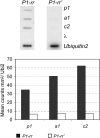RNA-dependent RNA polymerase is required for enhancer-mediated transcriptional silencing associated with paramutation at the maize p1 gene
- PMID: 18845841
- PMCID: PMC2600936
- DOI: 10.1534/genetics.108.095281
RNA-dependent RNA polymerase is required for enhancer-mediated transcriptional silencing associated with paramutation at the maize p1 gene
Abstract
Paramutation is the ability of an endogenous gene or a transgene to heritably silence another closely related allele or gene. At the maize p1 (pericarp color1) gene, paramutation is associated with decreases in transcript levels and reduced pigmentation of the endogenous allele that normally specifies red seed coat (pericarp) and cob pigmentation. Herein we demonstrate that this silencing occurs at the transcriptional level and that a specific enhancer fragment from p1 is sufficient to induce all aspects of paramutation. Further, we demonstrate that a mutation in the mop1 gene (mediator of paramutation1), which encodes a RNA-dependent RNA polymerase, is absolutely required for establishing the silencing associated with p1 paramutation. In contrast to its effects on other paramutation loci, the mop1 mutation does not immediately reactivate a previously silenced allele; several generations in the presence of the mop1 mutation are required. In addition, the mop1 mutation was also able to release tissue-specific silencing of another p1 allele that does not participate in paramutation, but does contain a tandem repeated structure and is likely regulated through epigenetic mechanisms. These results demonstrate that RNA-mediated gene-silencing mechanisms play key roles in p1 paramutation and the spectrum of roles for MOP1 is broadened to include tissue-specific expression patterns.
Figures






References
-
- Alleman, M., L. Sidorenko, K. McGinnis, V. Seshadri, J. E. Dorweiler et al., 2006. An RNA-dependent RNA polymerase is required for paramutation in maize. Nature 442 295–298. - PubMed
-
- Armstrong, C. L., 1994. Regeneration of plants from somatic cell cultures: applications for in vitro genetic manipulation, pp. 663–173 in The Maize Handbook, edited by M. Freeling and V. Walbot. Springer-Verlag, New York.
-
- Carey, C. C., J. T. Strahle, D. A. Selinger and V. L. Chandler, 2004. Mutations in the pale aleurone color1 regulatory gene of the Zea mays anthocyanin pathway have distinct phenotypes relative to the functionally similar TRANSPARENT TESTA GLABRA1 gene in Arabidopsis thaliana. Plant Cell 16 450–464. - PMC - PubMed
-
- Chandler, V. L., 2007. Paramutation: from maize to mice. Cell 128 641–645. - PubMed
Publication types
MeSH terms
Substances
LinkOut - more resources
Full Text Sources

